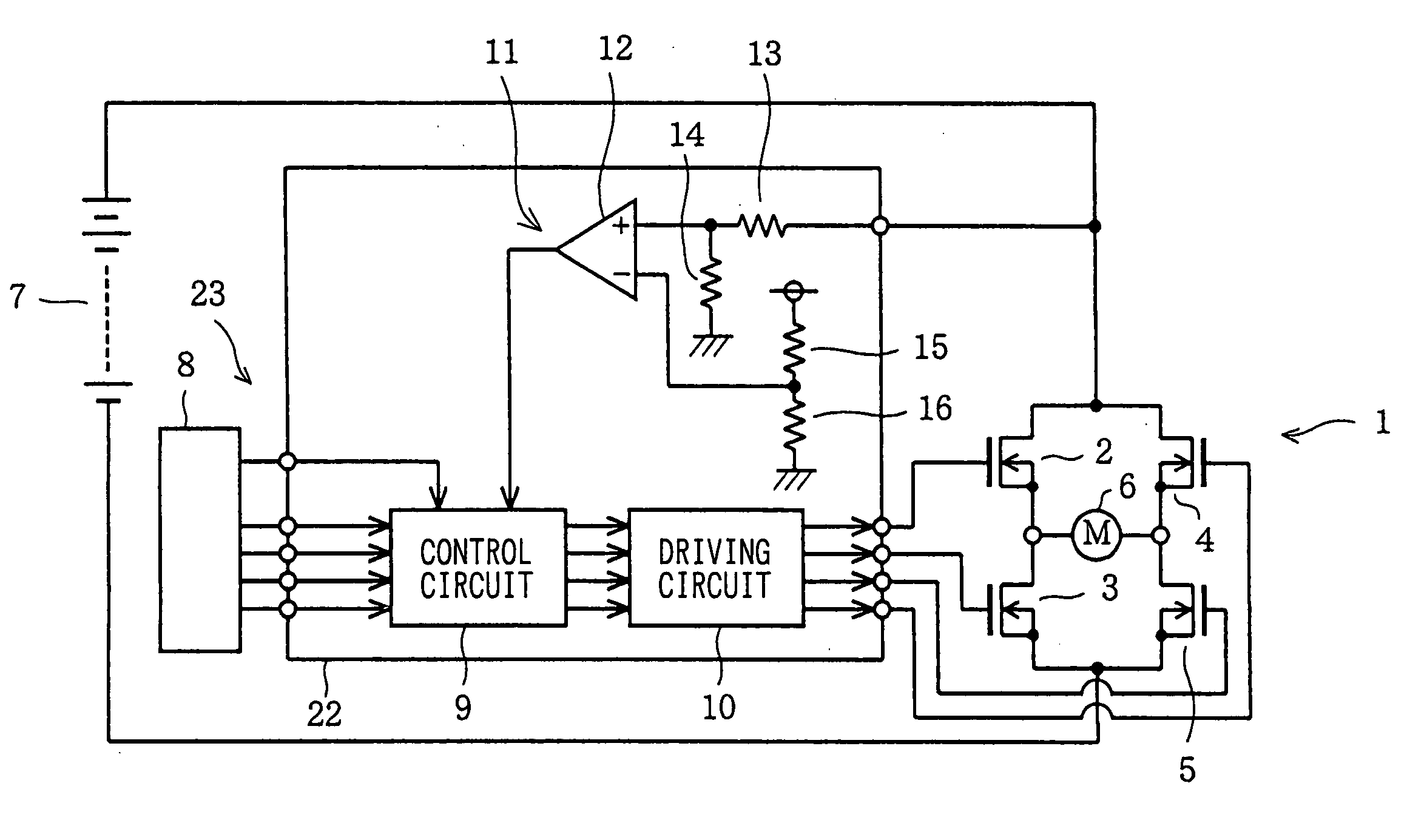Driving apparatus of H bridge circuit and protection method of the same
- Summary
- Abstract
- Description
- Claims
- Application Information
AI Technical Summary
Benefits of technology
Problems solved by technology
Method used
Image
Examples
first embodiment
[0037] Referring to FIGS. 1 to 5, a first embodiment implementing of an actuator ECU mounted on a vehicle as, for example, an ECU for driving a DC motor for opening and closing a throttle valve of the engine will be described. FIG. 1 is a diagram showing a configuration including an H bridge circuit 1 and a driving apparatus for driving the H bridge circuit 1. As shown in the figure, the H bridge circuit 1 comprises four N-channel power MOSFETs 2 to 5 wired to each other in a bridge connection. The N-channel power MOSFETs 2 to 5 are each used as a semiconductor switching-device. A DC motor 6 is connected to the H bridge circuit 1 as the load of the H bridge circuit 1. The DC motor 6 outputs a rotation power for opening and closing the throttle valve of the engine. The mechanism for applying the rotation power is not shown in the figures for ease of illustration. As a power supply for supplying power to the H bridge circuit 1, a battery 7 of the vehicle is employed. The battery 7 out...
sixth embodiments
Second to Sixth Embodiments
[0051] FIGS. 6 to 10 are diagrams showing second to sixth embodiments respectively. Only differences from the first embodiment are explained. These embodiments are different from each other in that they employ different types of semiconductor switching-devices in the H bridge circuit.
[0052] In the second embodiment shown in FIG. 6, the H bridge circuit 31 employs four NPN transistors 32 to 35. In the third embodiment shown in FIG. 7, the H bridge circuit 36 employs P-channel MOSFETs 37 and 38 on the side of the power supply as well as N-channel MOSFETs 39 and 40 on the side of the ground.
[0053] In the fourth embodiment shown in FIG. 8, the H bridge circuit 41 employs two PNP transistors 42 and 43 on the side of the power supply as well as two NPN transistors 44 and 45 on the side of the ground. In the fifth embodiment shown in FIG. 9, the H bridge circuit 46 employs N-channel MOSFETs 47 and 48 on the side of the power supply as well as P-channel MOSFETs ...
seventh embodiment
[0055] FIGS. 11 to 13 are diagrams showing a seventh embodiment of the present invention. The seventh embodiment includes the H bridge circuit 36 of the third embodiment shown in FIG. 7 and a concrete configuration of a driving apparatus 61. As described above, the H bridge circuit 36 employs the P-channel MOSFETs 37 and 38 on the side of the power supply. In such a configuration, a charge-pump circuit for a configuration including N-channel MOSFETs on the side of the power supply is not required. Thus, the seventh embodiment has a merit of a simple configuration of the driving circuit. However, in order to put these FETs 37 and 38 in an electrically non-conductive state in case a surge voltage is applied, a voltage having a level close to the surge voltage needs to be supplied to the gates of the FETs 37 and 38. For this reason, the driving apparatus 61 itself must be capable of enduring an applied high voltage and have a circuit configuration capable of putting the FETs 37 and 38 ...
PUM
 Login to View More
Login to View More Abstract
Description
Claims
Application Information
 Login to View More
Login to View More - R&D
- Intellectual Property
- Life Sciences
- Materials
- Tech Scout
- Unparalleled Data Quality
- Higher Quality Content
- 60% Fewer Hallucinations
Browse by: Latest US Patents, China's latest patents, Technical Efficacy Thesaurus, Application Domain, Technology Topic, Popular Technical Reports.
© 2025 PatSnap. All rights reserved.Legal|Privacy policy|Modern Slavery Act Transparency Statement|Sitemap|About US| Contact US: help@patsnap.com



